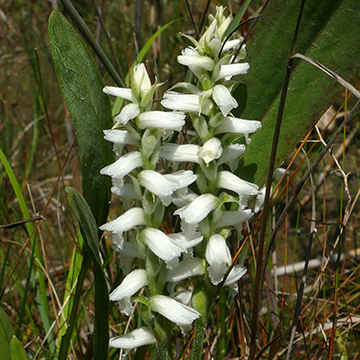

Spiranthes incurva - (image 1 of 7)
Taxonomy
Family: Orchidaceae
Habitat
Fens, wet meadows, dune swales, ditches.
Associates
Distribution
Middle, northern, and eastern Interior Lowlands, Western and Northern Appalachian Mountains and Adirondacks, Great Lakes Basin, and Prairie Peninsula from New Brunswick, southern Ontario, and southern Quebec, west to MN, central NE, and eastern KS.
Morphology
Perennial to 40 cm. Leaves typically remaining until anthesis and withering shortly after; flowers mostly 7.5 mm or longer, slightly tubularly campanulate, spreading to ascending, white, typically arranged in the inflorescence in 3-4 distinct vertical ranks; floral bracts nearly flat to moderately concave, either recurved, straight and spreading, or erect and weakly incurved, green or with prominent white hyaline margins or nearly wholly white; lateral sepals flattened, linear-lanceolate, acute, straight to slightly upwardly falcate, the tips often meeting the dorsal sepal and petals; labellum usually acuminate, abaxially white or very pale yellow, centrally smooth and yellowish (sometimes faintly), margin crisped and lacerate, abaxial glands spherical. 2n=45, 60.
Notes
Flowers mid August to September, rarely later
Wetland indicator: NA
This species is part of the Spiranthes cernua complex. It has been described as an ancient hybrid of S. cernua and S. magnicamporum. This taxon is similar to S. cernua which mostly replaces it along the coast and to the south. It differs from coastal and southern S. cernua in having a noticeably thickened labellum that is often centrally yellowish and has smaller callosities. The flowers are often arranged in 3-4 distinct ranks and the labellum acuminate, traits likely inherited from S. magnicamporum.
The type location that is the basis of the name Ibidium incurvum Jennings is an island in Lake Erie in Erie County, PA. The specific epithet "incurvum" of Jennings refers to the long, incurved callosities of plants from this site. Typical S. cernua s.s. also has long callosities and the degree to which they curve inward seems to vary considerably and this was later recognized by Jennings who indicated that I. incurvum could not be recognized. As described by Pace and Cameron, S. incurva has callosities that are very small, conical to rounded, and 0.3-0.8 mm tall, though examples have been observed with callosities up to 1.2 mm long. Both S. arcisepala and the more recently described S. sheviakii have been identified on the island, further complicating Jennings' original description.
The existence of intermediate forms and their likely hybrid nature was first recognized by Sheviak who called these plants the 'sand-prairie ecotype', the 'low prairie race' and later, after recognizing how widespread these plants were, included the 'southern prairie complex'. Sheviak did not go so far as to treat these as a distinct species given that they represent a "diverse assemblage of variably intermediate forms". He hypothesized that they were the result of unidirectional gene flow from S. magnicamporum to S. cernua and formed, in part, the basis of treating S. cernua as a compilospecies. It is not clear whether or not what Sheviak called the 'southern prairie complex' is actually synonymous with S. incurva, though the S. magnicamporum influence in these plants is clearly evident.
When this page was originally created, field observations seemed to indicate that plants in central NY down through northeastern PA exhibited some degree of introgression with S. cernua s.s. Genetics have shown that several plants originally determined to be S. incurva or S. cernua are actually S. arcisepala that have lateral sepals that are straight or sweeping upward rather than falcate. Therefore the distinct floral bracts, multiranked inflorescence, and acuminate lip appear to be among the more important diagnostic characteristics.
References
M. Hough and M.A. Young. 2021. A systematic survey of the Spiranthes cernua species complex (Orchidaceae) in New York. Native Orchid Conference Journal, 18(3): 22-56.
Pace, M.C. and Cameron, K.M. 2017. The systematics of the Spiranthes cernua species complex (Orchidaceae): Untangling the Gordian Knot. Systematic Botany, 42(4):1-30.
Sheviak, C.J. 1982. Biosystematic study of the Spiranthes cernua complex. New York State Museum Bulletin No. 448.
|
Michael Hough © 2017 |